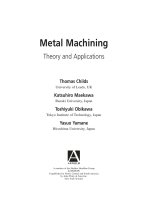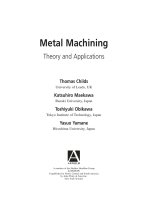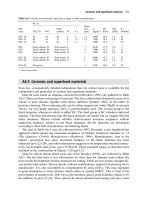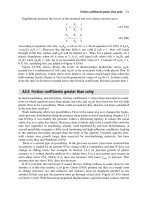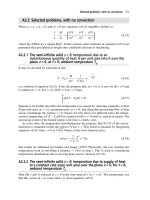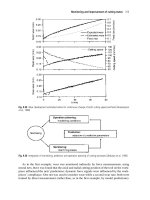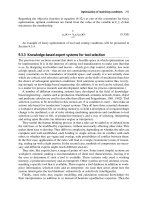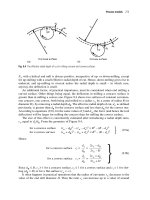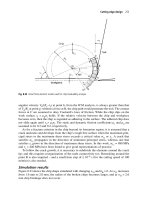Metal Machining - Theory and Applications Episode 2 Part 4 pptx
Bạn đang xem bản rút gọn của tài liệu. Xem và tải ngay bản đầy đủ của tài liệu tại đây (250.83 KB, 20 trang )
angular velocity V
h
/(R
c
–t
2
) at point h, from the ICM analysis, is always greater than that
of V
g
/R
c
at point g: without a force at B, the chip path would penetrate the tool. The contact
forces at C are assumed to obey Coulomb’s laws of friction. While the chip slips on the
work surface t
t
= m
d
s
t
holds. If the relative velocity between the chip and workpiece
becomes zero, then the chip is regarded as adhering to the surface. The adhered chip does
not slide again until t
t
> m
s
s
t
. The static and dynamic friction coefficients m
s
and m
d
are
assumed to be 0.3 and 0.2, respectively.
As for a fracture criterion in the chip beyond its formation region, it is assumed that a
crack nucleates and develops from the chip’s rough free surface when the maximum prin-
cipal stress or the maximum shear stress exceeds a critical value s
1c
or t
c
. A crack that
satisfies s
1c
propagates in the direction of minimum principal stress, whereas one that
satisfies t
c
grows in the direction of maximum shear stress. In this work, s
1c
= 880 MPa
and t
c
= 440 MPa have been found to give good representations of practice.
To follow the crack growth, it is necessary to subdivide the elements around the crack
tip; and this requires reorganization of the node connectivity too. Remeshing around the
point B is also required – and a small time step of ≤ 10
–6
s (for the cutting speed of 100
m/min) is also needed.
Simulation results
Figure 8.23 shows the chip shape simulated with changing w
G
and h
B
= 0. As w
G
increases
from 1.6 mm to 2.0 mm, the radius of the broken chips becomes larger; and at w
G
= 2.6
mm chip breakage does not occur.
Cutting edge design 253
Fig. 8.22 Initial finite element model used for chip breakability analysis
Childs Part 2 28:3:2000 3:18 pm Page 253
Increasing h
B
aids chip breakage. Figure 8.24 shows the development of chip shape with
time for w
G
= 2.6 mm but h
B
= 0.4 mm. Plastic deformation with e
—
˘
> 10 s
–1
takes place at the
hatched regions in the figure and the chip breaks after 25 ms (the time t is measured from the
instant at which the chip first collides with the workpiece surface). The figure also records the
contact forces. F
BH
and F
BV
are the horizontal and vertical force components acting at point
B, and F
CH
and F
CV
are those at point C. The small size of the forces at C and the almost
constant forces at B throughout the chip breaking cycle support the approximation that contact
of the chip with the work does not much alter the flow in the primary shear region.
254 Applications of finite element analysis
Fig. 8.23 Predicted chip shape with changing
w
G
(
h
B
=0)
Childs Part 2 28:3:2000 3:18 pm Page 254
The effect of undeformed chip thickness t
1
is considered in Figure 8.25, which compares
the predicted chip shape with experiment at w
G
= 2.14 mm and h
B
= 0. When t
1
is increased
from 0.10 mm to 0.36 mm, the chip shape is changed from continuous to segmented. In partic-
ular, an ear- (or e-) type chip is generated at t
1
= 0.25 mm. The simulated chip morphology,
including curl and thickness, is in good agreement with experiment (similar observations have
been reported by Jawahir, 1990). When the rake angle is decreased, the segmentation is accel-
erated and chips with a smaller radius are produced (Shinozuka et al., 1996b).
8.4.2 Three-dimensional cutting edge design
Tools with cut-away rake faces, to restrict the chip contact to be shorter than it would natu-
rally be, have advantages beyond that of chip control considered in the previous section.
Smaller cutting forces, lower cutting temperature, longer tool life, better surface finish and
the prevention of tool breakage can be achieved in practice, provided the restriction is
properly chosen (Chao and Trigger, 1959; Jawahir, 1988). Slip-line field plasticity theory
has been applied to two-dimensional machining with a cut-away tool, to analyse the
changes to chip flow caused by a restricted contact (Figure 6.6 – Usui et al., 1964). Here,
a closer-to-practice three-dimensional ICM finite element analysis is introduced of the
Cutting edge design 255
Fig. 8.24 Variation of chip shape and forces at
w
G
=2.6 mm and
h
B
=0.4 mm
Childs Part 2 28:3:2000 3:18 pm Page 255
effect – on steady-state chip formation, tool temperature and wear – of varying a cut-away
in the region of the nose radius of a single point P20-grade turning tool, used to turn an
18%Mn–18%Cr alloy steel, at a cutting speed of 60 m/min, a feed of 0.2 mm, and a depth
of cut of 2 mm, without coolant. The mechanical and thermal properties and friction and
wear behaviour, assumptions (from measurements) are listed in Table 8.4.
Simulation model
The three-dimensional analysis has been developed from the two-dimensional ICM
scheme described in Section 7.3. Figure 8.26 shows the analytical model for machining
with a single point tool at zero cutting edge inclination angle. The x- and y-axes are,
respectively, parallel and perpendicular to the cutting direction, and the z-axis is set along
the major cutting edge. The tool is assumed to be stationary and rigid, while the work-
piece has boundaries moving towards the tool at the specified cutting speed. Apart from
256 Applications of finite element analysis
Fig. 8.25 Comparison of predicted chip shape with experiment (
w
G
=2.14 mm and
h
B
=0)
Childs Part 2 28:3:2000 3:19 pm Page 256
the obvious differences stemming from converting two-dimensional finite element stiff-
ness equations to three-dimensional ones, the main complication is allowing the chip to
flow in the z-direction. The formulation of sliding friction behaviour at the tool–chip inter-
face is modified to allow for this: for a node i contacting the rake face, the following condi-
tions are imposed on the finite element stiffness equation:
Cutting edge design 257
Table 8.4 Mechanical and thermal properties used in simulation
Flow stress characteristics: s
—
= A (e
—
˘
/1000)
M
(e
—
/0.3)
N
GPa
where A = 2.01 exp(–0.00177T), M = 0.00468 exp(0.00355T),
N = 0.346 exp(–0.000806T) + 0.111 exp{–0.0000315(T–375)
2
}
Friction characteristic: τ/k = 1 – exp(–
µσ
n
/k)
dh
⎛
C
2
⎞
Wear characteristic: — = C
1
σ
n
exp ⎜– —— ⎟
ds
⎝
T
⎠
Young’s modulus E = 206 GPa, Poisson’s ratio
ν
= 0.3, Friction constant
µ
= 1.6,
Wear constants C
1
= 14.67 MPa
–1
, C
2
= 21 930 K
Thermal conductivity K Density,
ρ
Specific heat, C
[W m
–1
K
–1
] [kg m
–3
] [J kg
–1
K
–1
]
Workpiece 12.6 7950 502
(18%Mn–18% Cr steel)
Insert (carbide P20) 66.9 11200 402
Shank (0.55% C steel) 36.0 7750 461
Fig. 8.26 Three-dimensional machining model and boundary conditions
Childs Part 2 28:3:2000 3:19 pm Page 257
dt u˘
i
dt w˘
i
F
˘
˘
ix ′
=
(
——
)
————— F
˘
iy′
, F
˘
iz
=
(
——
)
————— F
˘
iy′
, v˘
i
= 0
ds
n
(u˘
i
2
+ w˘
i
2
)
½
ds
n
(u˘
˘i
2
+ w˘
i
2
)
½
(8.4)
where x′ and y′ are the local coordinate system as shown in the figure, F
˘
iy′
is the rate of
normal force on node i, and (u˘′
i
, v˘′
i
, w˘′
i
) are the velocities of node i in the (x′, y′, z′) direc-
tions. (dt/ds
n
) is the effective friction coefficient given by the differentiation of the fric-
tion characteristic, equation (2.24c). A further complication in description arises when a
chip flows into a cut-away groove in a primary (plane) rake face of a tool. Although this
has been dealt with in the example of Section 8.4.1, in the simulation in this section it is
assumed that a chip makes contact only with the primary rake face.
Figure 8.27 shows the finite element structure of the model. It is an assembly of linear
tetrahedral elements (7570 elements and 1887 nodes in all). The mesh shown is an ICM
initial-guess for turning with a plane rake faced tool, with cutting occurring over the major
and minor cutting edges and over the tool nose radius. The tool geometry is (a
p
= 0˚, a
f
=
0˚, g
p
= 6˚, g
f
= 6˚, k′
r
= 15˚, y = 15˚, R
n
= 1 mm) where the terms are defined in Figure
6.16. The mesh is automatically generated from a specified shear plane angle and chip
flow direction, the tool geometry, feed and depth of cut.
Cutting with this conventional, plane, tool is analysed as well as cutting with two cut-away
tools derived from it. Views of the two cut-away tools, types I and II, are shown in Figure 8.28.
Both of these tools have a secondary rake of angle 15˚ superimposed on the primary rake. The
type I tool has a restricted primary land width r that is constant along the major cutting edge
but reduces around the tool’s nose radius, to zero at the minor cutting edge, in the same way
that the uncut chip thickness varies. The type II tool has a restricted land width that is constant
258 Applications of finite element analysis
Fig. 8.27 Initial finite element mesh for a tool geometry (0º, 0º, 6º, 6º, 15º, 15º, 1.0mm) and
f
=0.2 mm,
d
=2 mm
Childs Part 2 28:3:2000 3:19 pm Page 258
around both the major and minor cutting edges. The influences of these design differences,
and also of varying the width r relative to the feed f are studied. The value of r over the major
cutting edge, divided by f, is referred to as the restriction constant K.
Simulation and experimental results
The simulation predicts that type I tools should create lower deformation in the workpiece
and lower tool temperature and wear than the plane faced or type II tools; and that K = 1.2
is a good value for the restriction constant. Experimental measurements, with tools of
different rake face geometries created by electro-discharge machining, of tool forces, rake
face temperatures – using a single-wire thermocouple (Figure 5.19(b), Usui et al., 1978) –
and tool wear, support this.
Figure 8.29 shows the final predicted chip shape and the distribution of equivalent plastic
Cutting edge design 259
Fig. 8.28 Rake face geometries of types I and II cut-away tools
Fig. 8.29 Equivalent plastic strain rate distribution and chip configuration when machining 18%Mn–18%Cr steel at
a cutting speed of 60 m/min,
f
= 0.2 mm and
d
= 2 mm with (a) conventional, (b) type I and (c) type II P20 carbide
tools
Childs Part 2 28:3:2000 3:19 pm Page 259
strain rate for the plane-faced tool and type I and II tools with K = 1.2. The type I tool
produces narrower plastic regions in the chip and workpiece, and less plastic deformation
over the finished surface, than the type II and plane tools. As well as the plane and type II
tools causing more deformation in the work surface beneath the major cutting edge, the
type II tool generates a thicker chip at the minor cutting edge, and the chip flow angle is
larger than for the other tools.
Figure 8.30 shows temperature distributions over the rake faces. The dark region repre-
sents the contact area with the chip, and the symbol * indicates the location of the highest
temperature. The maximum temperature of the type I tool is 50 to 100˚C lower than the
others. The type II tool produces a higher temperature than the type I tool at the minor
cutting edge and nose radius, where the chip contact area is wider. However, the distance
of the highest temperature from the major cutting edge is almost the same for both.
Figure 8.31 shows the predicted contour lines of constant wear rate. The distribution
and the isotherms in Figure 8.30 are closely correlated because temperature dominates the
wear (Table 8.4 and equation (4.1c)). The wear of the type II tool is severe at the corner
and near the major cutting edge, while the type I tool yields less wear along all its edges.
Comparisons with experiment are shown in Figures 8.32 to 8.34. Figure 8.32 shows
experimental measurements of cutting force variation with restriction constant K for the
type I tools. Experimentally, there is a minimum in all the force components at around K
= 1.2. The predicted forces show a similar tendency: predictions for the conventional and
type II tools are also included in the figure.
Figure 8.33 shows the measured and predicted rake face temperatures of the conven-
tional and type I (K = 1.2) tools in the direction of chip flow at the midpoint of the depth
of cut. A temperature difference of about 100˚C can be seen in both the predictions and
experiments, although prediction and experiment are not in absolute agreement with each
other.
260 Applications of finite element analysis
Fig. 8.30 Tool rake face isotherms in the conditions of Figure 8.29: (a) conventional, (b) type I; and (c) type II tools
Fig. 8.31 Contours of constant crater wear rate, conditions of Figure 8.29: (a) conventional; (b) type I; and (c) type II
tools
Childs Part 2 28:3:2000 3:19 pm Page 260
Figure 8.34 compares the differences in wear profiles at a cut distance of 600 m,
obtained both by profilometry and microphotography. The type I tool shows least tool
wear, more than 10% less than with the conventional tool: the similarity in wear distribu-
tion with that predicted in Figure 8.31 is clear.
In summary, a finite element machining simulation has been employed to analyse the
turning of a difficult-to-machine 18%Mn–18%Cr high manganese steel with a sintered
carbide three-dimensional cut-away tool. A cut-away design in which the primary
restricted contact length varies along the cutting edge in proportion to the uncut chip thick-
ness has been found to give a better performance than one with a restricted contact which
is constant along the major and minor cutting edges and around the tool nose radius; and
it is also better than a plane rake faced tool. A restriction constant of around 1.2 has been
found to give the least cutting forces, leading to reductions in cutting temperature and tool
wear.
Cutting edge design 261
Fig. 8.32 Cutting force dependencies on restriction constant
Fig. 8.33 Comparison of predicted and measured rake temperatures at the midpoint of the depth of cut, for plane
and type I tools
Childs Part 2 28:3:2000 3:19 pm Page 261
8.5 Summary
A new concept of computational or virtual machining simulation is starting to emerge,
based on the theoretical background surveyed in Chapter 7, to support the increasing
demands of high productivity, quality and accuracy of modern automated machining prac-
tice. There is no doubt that advances in computing capability and graphical visualization
technologies will bring further developments in the field of machining simulation.
At present, finite element simulation is mainly of use to mechanical and materials engi-
neers, as a tool to support process understanding, materials’ machinability development
and tool design. However, the computing time required by this method is too long for it to
be of use in machine shops for online control and optimization, although it can help offline
evaluation and rationalization of practical experience.
Online control requires other sorts of machining models. These and their relationships
with finite element models are the subject of the next and final chapter of this book, which
considers how to use modelling and monitoring in the production engineering context of
process planning and improvement.
References
Chao, B. T. and Trigger, K. J. (1959) Controlled contact cutting tools. Trans ASME J. Eng. Ind. 81,
139–151.
Hazra, J., Caffarrelli, D. and Ramalingam, S. (1974) Free machining steels – the behavior of type I
MnS inclusions in machining. Trans ASME J. Eng. Ind. 97, 1230–1238.
Jawahir, I. S. (1988) The tool restricted contact effect as a major influencing factor in chip breaking:
an experimental analysis. Annals CIRP 37(1), 121–126.
Jawahir, I. S. (1990) On the controllability of chip breaking cycles and modes of chip breaking in
metal machining. Annals CIRP 39(1), 47–51.
Jawahir, I. S. and van Luttervelt, C. A. (1993) Recent developments in chip control research and
applications. Annals CIRP 42(2), 659–693.
262 Applications of finite element analysis
Fig. 8.34 Measured crater depth and optical micrographs of worn tools at a cut distance of 600 m: (a) conventional,
(b) and (c) type I and II tools,
K
= 1.2
Childs Part 2 28:3:2000 3:19 pm Page 262
Johnson, W. and Kudo, H. (1962) The Mechanics of Metal Extrusion. Manchester: Manchester
University Press.
Lemaire, J. C. and Backofen, W. A. (1972) Adiabatic instability in the orthogonal cutting of steel.
Metallurgical Trans. 3(2), 477–481.
Maekawa, K., Kitagawa, T. and Childs, T. H. C. (1991) Effects of flow stress and friction character-
istics on the machinability of free cutting steels. Proc. 2nd Int. Conf. on The Behaviour of
Materials in Machining, Institute of Materials, York, pp. 132–145.
Maekawa, K., Ohhata, H. and Kitagawa, T. (1994) Simulation analysis of cutting edge performance
of a three-dimensional cut-away tool. In Usui, E. (ed.), Advancement of Intelligent Production.
Tokyo: Elsevier, pp. 378–383.
Marusich, T. D. (1999) private communication.
Marusich, T. D. and Ortiz, M. (1995) Modelling and simulation of high speed machining. Int. J. for
Num. Methods in Engng. 38, 3675–3694.
Nakayama, K. (1962) A study on the chip breakers. Bull. Japan Soc. Mech. Eng. 5(17), 142–150.
Naylor, D. J., Llewellyn, D. T. and Keane, D. M. (1976) Control of machinability in medium-carbon
steels. Metals Technol. 3(5/6), 254–271.
Obikawa, T. and Usui, E. (1996) Computational machining of titanium alloy – finite element model-
ing and a few results. Trans ASME J. Manufacturing Sci. Eng. 118, 208–215.
Obikawa, T., Matumara, T. and Usui, E. (1990) Chip formation and exit failure of cutting edge (1st
report). J. Japan. Soc. Prec. Eng. 56(2), 336–342.
Obikawa, T., Sasahara, H., Shirakashi, T. and Usui, E. (1997) Application of computational machin-
ing method to discontinuous chip formation. Trans ASME J. Manufacturing Sci. Eng. 119,
667–674.
Pekelharing, A. J. (1974) Built-up edge (BUE): is the mechanism understood? Annals CIRP 23(2),
207–212.
Pekelharing, A. J. (1978) The exit failure in interrupted cutting. Annals CIRP 27(1), 5–8.
Recht, R. F. (1964) Catastrophic thermoplastic shear. J. Appl. Mechanics 31(2), 189–193.
Sandstrom, D. R. and Hodowany, J. N. (1998) Modeling the physics of metal cutting in high speed
machining. Int. J. Machining Sci. and Tech. 2, 343–353.
Shaw, M. C., Usui, E. and Smith, P. A. (1961) Free machining steel (part III). Trans ASME J. Eng.
Ind. 82, 181–192.
Shinozuka, J. (1998) Analytical prediction of cutting performance of grooved rake face tools. PhD
Thesis. Tokyo: Tokyo Institute of Technology.
Shinozuka, J., Obikawa, T. and Shirakashi, T. (1996a) Chip breaking process simulation by thermo-
elastic plastic finite element method. J. Japan Soc. Prec. Eng. 62(8), 1161–1166.
Shinozuka, J., Obikawa, T. and Shirakashi, T. (1996b) Chip breaking analysis from the viewpoint of
the optimum cutting tool geometry design. J. Matls Processing Tech. 62, 345–351.
Trent, E. M. (1963) Cutting steel and iron with cemented carbide tools (part II). J. Iron Steel Inst.
201, 923–932.
Usui, E., Kikuchi, K. and Hoshi, T. (1964) The theory of plasticity applied to machining with cut-
away tools. Trans ASME J. End. Ind. B86, 95–104.
Usui, E., Shirakashi, T. and Kitagawa, T. (1978) Analytical prediction of three dimensional cutting
process (part 3). Trans ASME, J. Eng. Ind. 100, 236–243.
Usui, E., Ihara, T. and Shirakashi, T. (1979) Probabilistic stress-criterion of brittle fracture of carbide
tool materials. Bull. Japan Soc. Prec. Eng.
13(4), 189–194.
Usui, E., Maekawa, K. and Shirakashi, T. (1981) Simulation analysis of built-up edge formation in
machining of low carbon steel. Bull. Japan Soc. Prec. Eng. 15(4), 237–242.
Usui, E., Ihara, T., Kanazawa, K., Obikawa, T. and Shirakashi, T. (1982) An evaluation method of frac-
ture strength of brittle materials with disk compression test. J. Mat. Sci. Soc. Japan 19(4), 238–243.
Usui, E., Obikawa, T. and Matsumura, T. (1990) Chip formation and exit failure of cutting edge (2nd
report). J. Japan Soc. Prec. Eng. 56(5), 911–916.
References 263
Childs Part 2 28:3:2000 3:19 pm Page 263
Vyas, A. and Shaw, M. C. (1999) Mechanics of saw-tooth chip formation in metal cutting. Trans
ASME J. Manuf. Sci. and Engng. 121, 163–172.
Williams, J. E., Smart, E. F. and Milner, D. (1970) The metallurgy of machining, Part 2. Metallurgia
81, 51–59.
Yamaguchi, K. and Kato, T. (1980) Friction reduction actions of inclusions in metal cutting. Trans
ASME J. Eng. Ind. 103, 221–228.
Yamane, Y., Usuki, H., Yan, B. and Narutaki, N. (1990) The formation of a protective oxide layer in
machining resulphurised free-cutting steels and cast irons. Wear 139, 195–208.
264 Applications of finite element analysis
Childs Part 2 28:3:2000 3:19 pm Page 264
9
Process selection, improvement
and control
9.1 Introduction
This final chapter deals with the planning and control of machining processes. Planning
and control systems are composed of several modules, such as modules for process model-
ling, optimization and prediction; for selection of tools and cutting conditions; for tool
path generation; for machine tool operation; for monitoring and recognition; for diagnosis
and evaluation; for learning and tuning. Data and knowledge-base modules support a
system’s operation. There is overlap between the functions of some of these modules. In
the interests of efficient construction and operation, some of the modules may be
combined and some may be neglected in any particular system.
The quantitative modelling of machining processes, based on machining theory, with
the prediction or simulation that this enables, greatly assists planning and control. Figure
9.1 shows examples of systems containing a simulation module at their heart. The subject
of Section 9.2 is process models for prediction, simulation and control, but more widely
defined than in previous chapters of this book.
Initial process optimization is the subject of Section 9.3. The tasks and tools of opti-
mization depend on whether there is a single goal or whether there are conflicting goals
(and in that case how clear are their priorities); and whether the process is completely or
only partly modelled (how clear is the understanding). An example that approaches single
goal optimization of a well understood system is optimization of speed, feed and depth of
cut to minimize cost (or maximize productivity) once a cutting tool has been selected and
part accuracy and finish have been specified. This is the subject of Section 9.3.1. Even in
this case, all aspects of the process may not be completely modelled, or some of the coef-
ficients of the model may be only vaguely known. Consequently, the skills of practical
machinists are needed. Section 9.3.2 introduces how the optimization process may be
recast to include such practical experience, by using fuzzy logic.
Optimization becomes more complicated if it includes selection of the tool (tool holder
and cutting edge), as well as operation variables. The tool affects process constraints and,
at the tool selection level, constraints and goals can overlap and be in conflict (a surface
finish design requirement may be thought of both as a constraint and a goal, in conflict
with cost reduction). As a result of this complexity, tool selection in machine shops
currently depends more on experience than models. Section 9.3.3 deals with rule-based
tool selection systems, a branch of knowledge-based engineering.
Childs Part 3 31:3:2000 10:37 am Page 265
Because what tool is selected depends in part on the speeds, feed and depth of cut that
it will experience, tool selection systems commonly include rules on the expected ranges
of these variables. However, combined optimization of these and the tool would be better.
That is the topic of the last part of Section 9.3.
Section 9.4 is concerned with process monitoring. This is directly valuable for detect-
ing process faults (either gradual, such as wear; or sudden, such as tool failure or wrong
cutter path instructions). It may also be used, with recognition, diagnosis and evaluation of
cutting states, to improve or tune an initial process model or set of rules. Finally, Section
266 Process selection, improvement and control
Fig. 9.1 Model-based systems for design and control of machining processes: (a) CAD assisted milling process simu-
lator and planner (Spence and Altintas, 1994) and (b) machining-scenario assisted intelligent machining system
(Takata, 1993)
Childs Part 3 31:3:2000 10:37 am Page 266
9.5 is allocated to model (simulation) based control, which is one of the major destinations
of machining theory.
9.2 Process models
Models of machining processes are essential for prediction, control and optimization.
Especially important are models for cutting force, cutting temperature, tool wear, tool
breakage and chatter. Physically based models of these are the main concern of previous
chapters of this book. In this chapter, a broader view of modelling is taken, to include
empirical and feature-based models constructed by regression or artificial intelligence
methods. A model should be chosen appropriate for the purpose for which it is to be used;
and modified if necessary. The more detailed (nearer-to-production) the purpose and the
quicker the response required of the system, the more likely it is that an empirical model
will be the appropriate one; but a physical model may guide the form of the empirical
model and its limits of applicability. The different types of models are reviewed here.
Cutting force models are considered first, because of their general importance, both
influencing tool breakage, tool wear and dimensional accuracy, as well as determining
cutting power and torque. Tool paths in turning are more simple than in milling; and this
leads to smaller force variations during a turning than during a milling process. For the
purposes of control, force models applied to turning tend to be simpler than those applied
to milling. However, accuracy control in milling processes, such as end milling, is very
important technologically. Here, two sections are devoted to force models, the first gener-
ally to turning and the second specially to end milling.
9.2.1. Cutting force models (turning)
Cutting forces in turning F
T
= {F
d
, F
f
, F
c
} may be written in terms of a non-linear system
H and operation variables x
T
= {V, f, d}:
F = H(x) (9.1)
The non-linear system H may be a finite element modelling (FEM) simulator H
FEM
,as
described in Chapters 7 and 8, an analytical model H
A
(for example the three-dimensional
energy model described in Section 6.4), a regression model H
R
, or a neural network H
NN
(Tansel, 1992). The coefficients and exponents of a regression model and the weights of a
neural network are most often determined from experimental machining data, by linear
regression or back propagation algorithms, respectively. However, they may alternatively
be determined from calculated FEM or energy approach results. They then become the
means of interpolating a limited amount of simulated data. In addition to the operation
variables, a tool’s geometric parameters, such as rake angles, tool nose radius and
approach angle, may be included in the variables x.
An extended set of variables x
—
can be developed, to include a tool’s shape change due
to wear w, where w is a wear vector, the components of which are the types of wear
considered: x
—
T
= {x
T
, w
T
}. The cutting forces may be related to this extended variable set,
similarly to equation (9.1):
F = H
–
(x
—
) (9.2a)
Process models 267
Childs Part 3 31:3:2000 10:37 am Page 267
A regression model example of such a non-linear equation (to be used in Section 9.4), for
machining a chromium molybdenum low alloy steel BS 709M40 (British Standard, 1991)
with a triple-coated carbide tool insert of grade P30 and shape code SPUN 120312
(International Standard, 1991), held in a tool holder of code CSTPR T (International
Standard, 1995), has been established as:
F
d
= 500f
0.46
d
0.810
+ 2377(VS
1.93
– 0.007ln V)
× (VB
0.26
– 0.007ln V) (VN
–0.33
– 0.007ln V)
F
f
= 629f
0.30
d
0.720
+ 1199(VS
3.58
– 0.023 V
0.27
)
}
(9.2b)
× (VB
–0.66
– 0.23 V
0.27
) (VN
0.03
– 0.23 V
0.27
)
F
c
= 1862f
0.94
d
1.11
+ 2677(VS
0.24
– 0.05ln V)
×(VB
0.23 –
0.05ln V) (VN
0.16
– 0.05ln V)
where F
d
, F
f
, and F
c
are values in N; V, f and d are in m/min, mm/rev and mm, respec-
tively; and the dimensions of flank wear VB (Chapter 4), notch wear VN and nose wear VS
are in mm (Oraby and Hayhurst, 1991).
9.2.2 Cutting force models (end milling)
The end milling process is complex compared with turning, both because of its more
complicated machine tool linear motions and its repeated intermittent engagement and
disengagement of rotating cutting edges. However, as already written, it is very important
from the viewpoint of process control in modern machining technologies. This section
deals extensively with end milling because of this importance and also because some of
the results will be used in Section 9.5, on model-based process control. A general model
is first introduced, followed by particular developments in time varying, peak and average
force models, and the use of force models to develop strategies for the control of cutter
deflection and part accuracy.
A general model
The three basic operation variables, V, f, d, of turning are replaced by four variables V, f,
d
R
, d
A
in end milling, where, from Chapter 2.2, the cutting speed V = pDW, the feed f is
the feed per tooth U
feed
/(N
f
W), and d
R
and d
A
are the radial and axial depths of cut. In
terms of a non-linear system H′ and operation variables x
T
= {V, f, d
R
, d
A
}, the cutting
forces on an end mill may be written similarly to equation (9.1):
F = H′(x) (9.3)
where F is the combined effect of all the active cutting edges.
End milling’s extra complexity relative to turning has led to regression force models
H′
R
being most developed and contributing most to its process control. FEM models as in
Chapters 7 and 8, H′
FEM
and analytical approaches H′
A
(for example Shirakashi et al.,
1998, 1999; Budak et al., 1996), are developing, but are not yet at a level of detail where
they may usefully be applied to process control. Neural networks H′
NN
have not been of
interest.
Time-varying models
Implementations of equation (9.3), able to follow the variations of cutting force with time,
may be constructed by considering the contributions of an end mill’s individual cutting
268 Process selection, improvement and control
Childs Part 3 31:3:2000 10:37 am Page 268
edges to the total forces. Figure 9.2(a) – similar to Figure 2.3 but developed for the purposes
of process control and which will be used further in Section 9.5 – shows a clockwise-rotat-
ing end mill with N
f
flutes (four, in the figure). The end mill is considered to move over and
cut a stationary workpiece, in the same way that the tool path is generated. A global coor-
dinate system (x′, y′, z′), fixed in the workpiece, is necessary to define the relative positions
of the end mill and workpiece so that instantaneous values of d
R
and d
A
may be determined.
Cutting forces are expressed in a second coordinate system (x, y, z) with axes parallel to (x′,
y′, z′) but with the origin fixed in the end mill. The forces are obtained from the summation
of force increments calculated in local coordinate systems (r, t
n
, z
E
) with axes in radial,
tangential and axial directions and origins O
E
on the helical cutting edges.
When the tool path is a straight line (as in Figure 9.2(a)), it is clear which dimension is
Process models 269
Fig. 9.2 Milling process: (a) coordinates and angles in a slice by slice model and (b) the effective radial depth of cut
with curved cutter paths
Childs Part 3 31:3:2000 10:37 am Page 269
the radial depth of cut, d
R
; but when the tool path is curved (Figure 9.2(b)), there is a
difference between the geometrical radial depth d
R
and an effective radial depth d
e
(described further in the next section): a fourth coordinate system (X, Y, Z) with the same
origin as (x, y, z) but co-rotating with the instantaneous feed direction, so that the feed
speed U
feed
is always in the X direction, deals with this.
The starting point of the force calculation is to calculate the instantaneous values of
uncut chip thickness f ′ in a r–t
n
plane, along the end mill’s cutting edges. For an end mill
with non-zero helix angle l
s
, a cutting edge is discretized into M axial slices each with
thickness Dz = d
A
/M (Kline et al., 1982). The plan view in Figure 9.2(a) shows the cutting
process in the mth slice from the end mill tip. An edge numbered i proceeds ones numbered
less than i. An edge enters into and exits from the workpiece at angles q
entry
and q
exit
(q
entry
< q
exit
) measured clockwise from the y-axis, as shown. At a time t, the angular position of
the point O
E
on the ith edge of slice m is q(m, i, t), also measured clockwise from the y-
axis. Choosing the origin of time so that q(1, 1, 0) = 0,
2p 2(m – 1)Dz
q(m, i, t) = Wt + —— (i – 1) – ————— tan l
s
(9.4)
N
f
D
For the cutting edge at O
E
to be engaged in cutting,
q
entry
+ 2pn ≤ q(m, i, t) ≤ q
exit
+ 2pn (9.5a)
where n is any integer. Then the cutting forces acting on the thin slice around O
E
are
DF
x
–F*
t
cos(q(m, i, t)) – F*
r
sin(q(m, i, t))
DF
x
(m, i, t) =
{
DF
y
}
=
{
F*
t
sin(q(m, i, t)) – F*
r
cos(q(m, i, t))
}
f ′(m, i, t)Dz
DF
z
F*
z
(9.5b)
270 Process selection, improvement and control
Fig. 9.2
continued
Childs Part 3 31:3:2000 10:37 am Page 270
where F*
t
, F*
r
and F*
z
are the specific cutting forces in the tangential, radial and axial direc-
tions, respectively.
On the other hand, when the cutting edge at O
E
is not engaged in cutting,
q
exit
+ 2p(n – 1) < q(m, i, t) < q
entry
+ 2pn (9.5c)
and
DF
x
(m,i,t) = 0 (9.5d)
The total cutting forces are obtained from the sum of the forces on all the slices:
F
x
(t)
MN
f
F
x
(t) =
{
F
y
(t)
}
=
∑∑
DF
x
(m, i, t) (9.6)
F
z
(t)
m=1 i=1
A physical force model would seek to express the specific forces in equation (9.5b) as
functions of cutting speed, uncut chip thickness and depth of cut. The purpose of end
milling process control force models is to determine force variations under conditions of
varying d
R
and d
A
, commonly at constant cutting speed. The specific cutting forces are
usually written as a regression model good for one speed only, in which the variables are
chosen from d
R
, d
A
, f (feed per tooth) and f ′; and the influence of cutting speed is subsumed
in the regression coefficients. Equations (9.7) are three examples of regression equations,
due respectively to Kline et al. (1982), Kline and De Vor (1983) and Moriwaki et al. (1995):
k
t0
+ k
t 1
d
R
+ k
t2
d
A
+ k
t 3
f + k
t4
d
R
d
A
+ k
t5
d
R
f
F*
t
+ k
t6
d
A
f + k
t7
d
2
R
+ k
t8
d
2
A
+ k
t9
f
2
{}
=
{}
(9.7a)
F*
r
/F*
t
k
r0
+ k
r1
d
R
+ k
r2
d
A
+ k
r3
f + k
r4
d
R
d
A
+ k
r5
d
R
f
+ k
r6
d
A
f + k
r7
d
2
R
+ k
r8
d
2
A
+ k
r9
f
2
F*
t
k
t1
( f ′
av
)
–k
t2
{}
=
{}
(9.7b)
F*
r
/F*
t
k
r1
( f ′
av
)
–k
r2
or
F*
t
k
t0
+ k
t1
(f ′)
–k
t2
{}
=
{}
(9.7c)
F*
r
/F*
t
k
r0
+ k
r1
(f ′)
–k
r2
where the k
ij
(i = t, r; j = 0 to 9) are constants and f ′
av
is the average uncut chip thickness
per cut. These formulations are used for the model (simulation) based process control to
be described in Section 9.5.
Peak and average force models
If only the peak or mean cutting force is to be used for process control, the force equation
(9.6) may be simplified, by working with the (X, Y, Z ) coordinate system; and it becomes
practical explicitly to re-introduce the influence of cutting speed. As the tool always feeds
in the X direction, it is the depth of cut, d
e
, in the Y direction, measured from the tool entry
point, which enters into calculations of the uncut chip thickness and which acts as the
effective radial depth of cut. It is this which should be used in force regression models.
Consequently, the peak resultant cutting force F
R, peak
and its direction measured clock-
wise from the Y axis, q
R, peak
, may be simply expressed as
Process models 271
Childs Part 3 31:3:2000 10:37 am Page 271
F
R, peak
= F
*
R
f
m
R1
d
m
e
R2
d
m
A
R3
V
m
R4
+ F
R0
(9.8a)
q
R, peak
= q
*
R
f
m
R5
(D – d
e
)
m
R6
d
m
A
R7
V
m
R8
+ q
R0
(9.8b)
where F
*
R
, F
R0
, q
*
R
, q
R0
and m
Rj
( j = 1 to 8) are constants. (In a slotting process, when d
e
= D, the cutting conditions have the least influence on q
R, peak
.)
The X and Y force components obtained from equations (9.8a) and (9.8b) are
F
Xp
= F
R, peak
sin q
R, peak
(9.8c)
F
Yp
= F
R, peak
cos q
R, peak
(9.8d)
The mean values may be expressed similarly to the peak values.
An example of a regression model in the form of equations (9.8) (to be used in the next
section) can be derived from down-milling data for machining the nickel chromium
molybdenum AISI 4340 steel (ASM, 1990), used by Kline in developing equation (9.7a)
(Kline et al., 1982). With F
R, mean
in newtons and q
R, mean
in degrees, the feed per tooth,
the effective radial depth of cut and the axial depth of cut in mm, and no information on
the influence of cutting speed,
F
R, mean
= 38 f
0.7
d
e
1.2
d
A
1.1
+ 222 (9.8e)
q
R, mean
= 4.86f
0.15
(D – d
e
)
0.9
– 26 (9.8f)
Dimensional accuracy and control
The force component F
Y
causes relative deflection between the tool and workpiece normal
to the feed direction. In principle, this gives rise to a dimensional error unless it is compen-
sated. Figure 9.3 shows the direction of forces acting on an end mill: the force component
272 Process selection, improvement and control
Fig. 9.3 Machining error and cutting force direction in up and down-milling
Childs Part 3 31:3:2000 10:37 am Page 272
